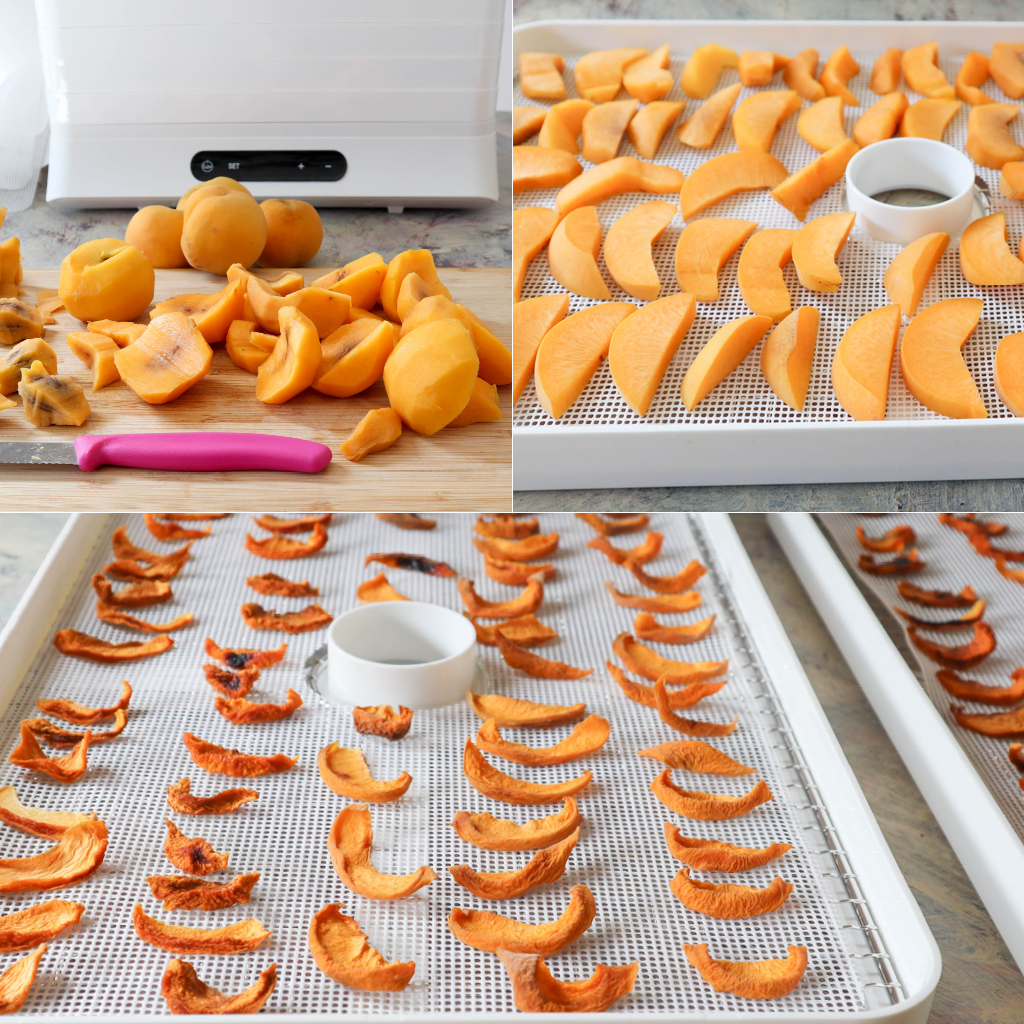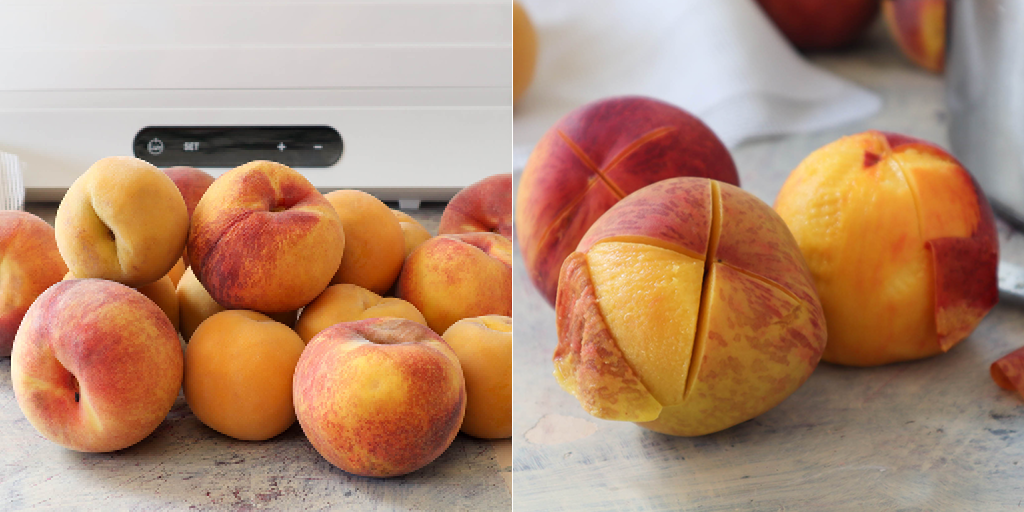Ihr Warenkorb ist leer
0
Ihr Warenkorb ist leer
Ihr Warenkorb ist leer
Add description, images, menus and links to your mega menu
A column with no settings can be used as a spacer
Link to your collections, sales and even external links
Add up to five columns
Add description, images, menus and links to your mega menu
A column with no settings can be used as a spacer
Link to your collections, sales and even external links
Add up to five columns
Barb Hodgens loves to cook with alternative, healthy whole food ingredients, with a focus on gut health. Barb has overcome her own gut health issues through healthy eating. Share your ideas, comments and photos at the end of this post :)

We all know that come summertime, peach season is fleeting. Whether you have an abundance in your orchard or just love to buy them up at the markets, dehydrating is one of the easiest ways to preserve your bounty so you can enjoy peaches all year. Dehydrated peach is sweet, delicious and truly candy-like!
Choose peaches that are completely ripe. The more flavourful the fresh peaches are to start out with, the more delicious the dehydrated version will be. You want all the sugars to have fully developed, so the dehydrated slices taste rich and chewy.

Dehydrated peach slices are a tasty and portable snack as they are but there are many other delicious ways to use them. Chopped up pieces of peach are great added to breakfast cereals such as homemade muesli and granola or added to trail mixes for when you are on the go. You can also rehydrate them and add the plumped-up pieces of peach to your homemade cakes and muffin batters, pies, granola bars and much more. Simply put the slices of dehydrated peach in a bowl and cover with hot water for 15 to 30 minutes. Drain the water and add to your favourite baking recipes.

Before selecting peaches for dehydrating, you should know that there are two types of peaches to choose from. Freestone and clingstone; either variety can be dehydrated, but the preparation for each is slightly different.
The flesh of these peaches cling to the pit making it difficult to slice them in uniform pieces. Peeling the skin is optional, however the flavour is sweeter, and the texture is less chewy with the skins removed. We recommend it with store bought peaches. Wash the peaches thoroughly if you prefer to leave the skins on.
Peeling clingstone peaches must be done by hand using a sharp paring knife or vegetable peeler. Once the peel is removed cut the peach flesh away from the pit with a knife.

Freestone peaches are more suitable for dehydrating because the pits pull out of the flesh making them easier to slice. Peeling freestone peaches is optional as well however the extra work removing the skin is well worth it because they'll taste sweeter. Wash the peaches thoroughly if you choose to leave the skin on. The quickest way to remove the skin on freestone peaches is to blanch them. This step does not work on the clingstone variety.
1. Cut an ‘X’ into the bottom of each peach.
2. Boil a large pot of water. Once boiling, place approx. 6 peaches (depending on pot size) in the water for 30 seconds.
3. Remove the peaches to a bowl of cold water to avoid cooking the peach too much.
4. Once they are cooled, with your fingers, gently peel the skin back from the incision lines. The skin should peel away easily. If the peaches are unripe or damaged, some areas of skin may stick. If this happens cut the skin away with a knife or vegetable peeler.


If you are concerned about your peaches turning brown (it's only aesthetic, and nothing to worry about), soak the slices in an acidic medium before placing on the dehydrator trays. Learn more about that here. We skipped this step because we didn’t want our peach slices soaking up more water and taking longer to dehydrate.
1. Cut the peaches into even slices (1/8- to 1/4-inch thick)
2. Optional step – place all the slices in acidulated water and then drain in a colander. Learn more here.
3. Line the Breeze Food Dehydrator trays with silicon mesh sheets to avoid the peach slices sticking or falling through the wire racks.
4. Arrange the slices on the trays, allowing a little space between for airflow.
5. Set the Breeze food dehydrator to 60C/140F and set the temperature to 10 hours to check in. If they are moist and sticky, continue to dry them, checking every few hours. Finished peaches will be pliable and leathery with no signs of moisture. To test, remove a slice and let it completely cool. You should be able to bend it. Tear and squeeze the thickest part. If there are any signs of moisture, leave them in the dehydrator for longer. It might take up to 20 hours to fully dry the peaches depending on how thickly they are sliced and the humidity on the day.
Conditioning is a process that allows any moisture differences between the pieces to balance out. Find out how here. If you plan to eat the peaches within the next 3 months, you can skip this step. The process is only necessary if you plan to keep your dehydrated peaches in long term storage.
Store dried peaches in a tightly sealed glass container, in a cool dark place. If finished correctly dehydrated peaches should last for months – to over a year.



We all know that come summertime, peach season is fleeting. Whether you have an abundance in your orchard or just love to buy them up at the markets, dehydrating is one of the easiest ways to preserve your bounty so you can enjoy peaches all year. Dehydrated peach is sweet, delicious and truly candy-like!
Choose peaches that are completely ripe. The more flavourful the fresh peaches are to start out with, the more delicious the dehydrated version will be. You want all the sugars to have fully developed, so the dehydrated slices taste rich and chewy.

Dehydrated peach slices are a tasty and portable snack as they are but there are many other delicious ways to use them. Chopped up pieces of peach are great added to breakfast cereals such as homemade muesli and granola or added to trail mixes for when you are on the go. You can also rehydrate them and add the plumped-up pieces of peach to your homemade cakes and muffin batters, pies, granola bars and much more. Simply put the slices of dehydrated peach in a bowl and cover with hot water for 15 to 30 minutes. Drain the water and add to your favourite baking recipes.

Before selecting peaches for dehydrating, you should know that there are two types of peaches to choose from. Freestone and clingstone; either variety can be dehydrated, but the preparation for each is slightly different.
The flesh of these peaches cling to the pit making it difficult to slice them in uniform pieces. Peeling the skin is optional, however the flavour is sweeter, and the texture is less chewy with the skins removed. We recommend it with store bought peaches. Wash the peaches thoroughly if you prefer to leave the skins on.
Peeling clingstone peaches must be done by hand using a sharp paring knife or vegetable peeler. Once the peel is removed cut the peach flesh away from the pit with a knife.

Freestone peaches are more suitable for dehydrating because the pits pull out of the flesh making them easier to slice. Peeling freestone peaches is optional as well however the extra work removing the skin is well worth it because they'll taste sweeter. Wash the peaches thoroughly if you choose to leave the skin on. The quickest way to remove the skin on freestone peaches is to blanch them. This step does not work on the clingstone variety.
1. Cut an ‘X’ into the bottom of each peach.
2. Boil a large pot of water. Once boiling, place approx. 6 peaches (depending on pot size) in the water for 30 seconds.
3. Remove the peaches to a bowl of cold water to avoid cooking the peach too much.
4. Once they are cooled, with your fingers, gently peel the skin back from the incision lines. The skin should peel away easily. If the peaches are unripe or damaged, some areas of skin may stick. If this happens cut the skin away with a knife or vegetable peeler.


If you are concerned about your peaches turning brown (it's only aesthetic, and nothing to worry about), soak the slices in an acidic medium before placing on the dehydrator trays. Learn more about that here. We skipped this step because we didn’t want our peach slices soaking up more water and taking longer to dehydrate.
1. Cut the peaches into even slices (1/8- to 1/4-inch thick)
2. Optional step – place all the slices in acidulated water and then drain in a colander. Learn more here.
3. Line the Breeze Food Dehydrator trays with silicon mesh sheets to avoid the peach slices sticking or falling through the wire racks.
4. Arrange the slices on the trays, allowing a little space between for airflow.
5. Set the Breeze food dehydrator to 60C/140F and set the temperature to 10 hours to check in. If they are moist and sticky, continue to dry them, checking every few hours. Finished peaches will be pliable and leathery with no signs of moisture. To test, remove a slice and let it completely cool. You should be able to bend it. Tear and squeeze the thickest part. If there are any signs of moisture, leave them in the dehydrator for longer. It might take up to 20 hours to fully dry the peaches depending on how thickly they are sliced and the humidity on the day.
Conditioning is a process that allows any moisture differences between the pieces to balance out. Find out how here. If you plan to eat the peaches within the next 3 months, you can skip this step. The process is only necessary if you plan to keep your dehydrated peaches in long term storage.
Store dried peaches in a tightly sealed glass container, in a cool dark place. If finished correctly dehydrated peaches should last for months – to over a year.


Sign up to get the latest on sales, new releases and more …